I have completed Adventure Quest, and as usual, my previous posts on the game are needed to understand this one.
I completed the game with no hints.

In some of the later printings of Level 9 games they included this paper you could send by physical mail for a clue. From the Museum for Computer Adventure Games.
I was very much on track to win already; the problem with this sort of game is you never quite know if you’re inches away or miles. All that is really needed to finish from where I ended is
1.) getting all four stones plus the talisman together at the end, which is more trouble than it sounds like
2.) also bringing the “onion” that’s really garlic (except I found out after the fact I didn’t need to tote it around at all)
You get “locked in” at the last part with all four inventory slots spoken for, so it turns out you don’t need to laboriously bring over the silver ball, the stick that makes fruit, etc.
I left off on a marsh where I found a Mist-Stone and teleported to escape (you find boots later which let you just trudge back through quicksand, but I only found them after I already had the stone liberated). The whole marsh area is tricky insofar as hands keep trying to grab you, and you need to HIT them with your sword to shake them loose. The sword occupies one of the four crucial inventory slots.
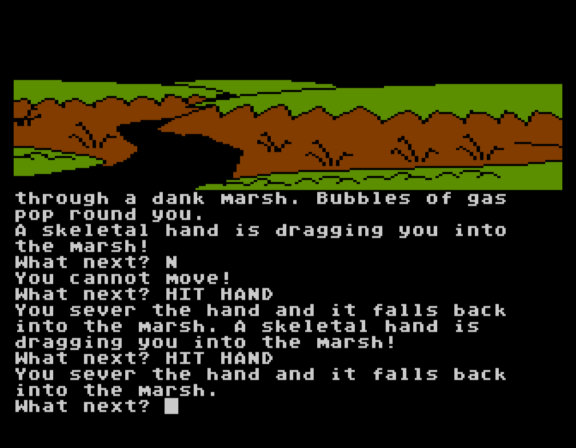
For a while, I was toting the sword and the insulated cloak and the magic lamp and making runs back and forth to tote items forward using my one available inventory slot (it turns out there was a faster way, but just like with the boots and the Mist-Stone I only realized this after the fact). Still, in a text game it doesn’t take that long to shove things forward, and eventually, I had the Stones plus the talisman. I also brought the “onion” (garlic) along because I had found this building on a side path in the marsh:
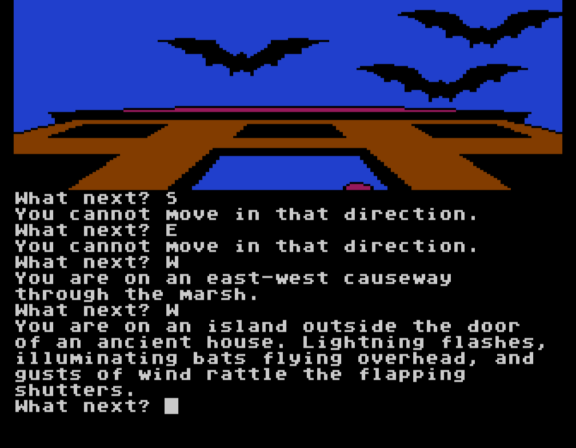
Gee, I wonder what’s inside?
I first thought I needed to cut the garlic or throw it, but you’re actually supposed to eat it, attaining permanent garlic breath. I could have done this at the very start of the game, even.

At the top of the building are some boots (the ones that protect from quicksand) and a window. The window is one-way but you can pitch all five items (Stones + talisman) before going through. Then it’s just a short walk through more quicksand (hope you kept the boots) and the Black Tower.

In the room back at the lake that sucks down items, they go to the quicksand room. I found this out after doing most of my work toting things through the biomes of the game, though.
What follows is simply a series of doors of different colors, and you insert each of the stones. This is a satisfying sequence despite — really, because of — the simplicity of it. The work is already done, you’re just proving it.

At the gold door and above you are locked in one-way, which is why — as I mentioned before — you are stuck with all four of your inventory slots full: three Stones, plus the Talisman. This was honestly helpful because it meant I could stop tracking all those previous items in the game thinking they’d may yet be useful. (Maybe the picnic table from the very start is useful in the final battle, who knows!)
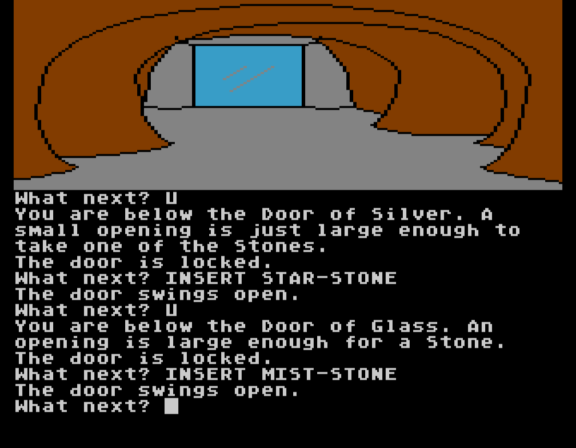
Once on top you get a forced sequence where you are surrounded by orcs and pushed to the face-off with AGALIAREPT. Given there’s only one inventory item left it isn’t hard to figure out what to do.


You give the demon chase; the orcs chase you. This is a very short section where there are tunnels with dead ends but you just need to find the right room to hide in.
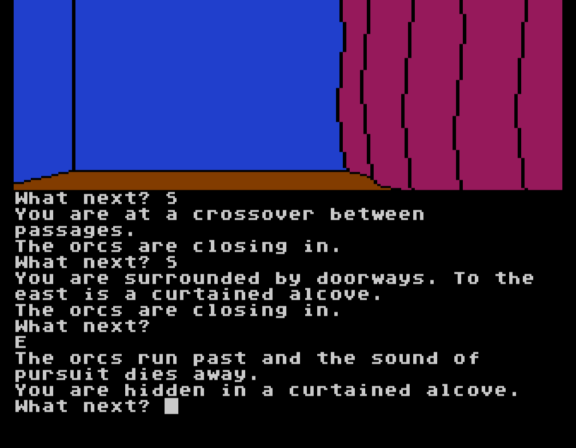
Having juked the orcs, you can go down a previously blocked passage to find the central lair of the demon.
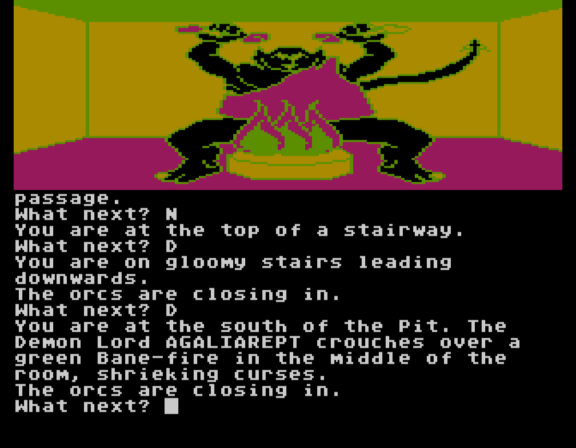
The Phoenix has been following us around (as visible if you just stop and WAIT or LOOK) and now is its time to shine, as was told in the prophecy:
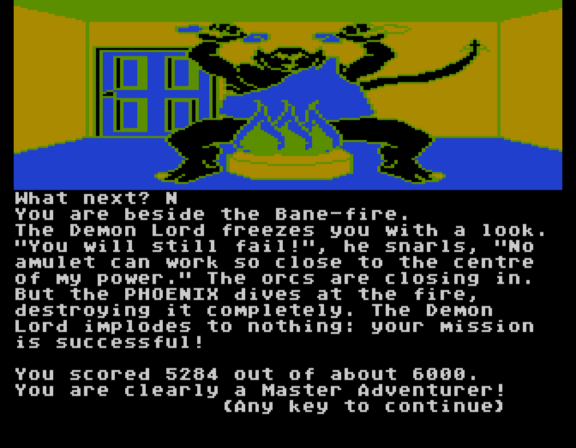
No idea what’s up with the point system, I don’t care much but I am not surprised there’s a wide possible range. The structure of this game led to more alternate solves but in an unusual way. That is, there are some puzzles you can simply ignore.
Remember the octopus I killed with an air-filled bag? You don’t need to fight it at all. It lurks at the white dot in the lake, and there’s a black dot right at the final quicksand that goes there, but there’s no need to use it. You can either a.) properly anticipate which items should be tossed through the window to the final area so you don’t have to go back or b.) use the magic lamp to teleport instead. Shockingly, giving how much magic lamp use I had in the game, I went with a.
The moor where you get cold? The insulated cloak works (I was keeping it because I was using the fire-stair at the volcano) but you technically can walk all the way from your teleport landing point to safety without it. Or you can use the brazier (the one that was “glowing like a commercial”) by dropping it so it provides warmth. Or you can eat a fruit (according to Ilmari Jauhiainen, I never even discovered that). And if you’re out of fruit, you can drop the stick which provides more fruit, and finally I understand why the item exists.
Again, I want to emphasize: the unusual aspect here isn’t alternate solutions so much as the ability to ignore the existence of a puzzle. I had no idea removing the djinn from the oasis was meant to be a puzzle until later. The fact you could run by the tentacles really suggests that the authors purposefully engineered a way to ignore the whole sequence in getting the ruby and throwing it. This means someone could blissfully skip the unfair puzzle at the slab (SAY OPEN SESAME) and maybe even think it was scenery and not a puzzle at all! A player could even skip the sphinx, snakes, and priestess; at least it seems clear you’re intended to solve something there. But it’s definitely still possible to at least skip the sphinx and think that maybe teleportation was the intended route!
While I eventually found the lung-fish model, I ended up never strictly needing it; even lighting up the dark portion of the underwater was optional. You might think that there’s no way someone would pass by dark rooms and without realizing there’s a puzzle, but at the very start of the game — in the first building — there’s a dark room that never gets lit up! With teleport luck you could probably bring the jellyfish down into the well but maybe the authors never even bothered to give the room a description and you’d see a glitch.
I will admit I would only recommend Adventure Quest to others under very specialized circumstances. The mazes weren’t bad — except for the very start I wouldn’t say the game had mazes as much as tricky geography to keep track of — but the four-item limit is really obnoxious after a while, and it gave me tension the entire game wondering if I needed to go back yet again to my stash (a convoluted operation) to test another object out for solving a puzzle.
The endgame was satisfying, though. It was in a way very quick and easy, and I think designers are afraid of something like that — making a gameplay denouement when the plot is at its climax — but it works, as the game was all about pre-planning, so the ending is just showing the result of all the player’s planning falling into place.
Trilogies help. Adventure Quest sells as people play Colossal. Middle Earth was a convenient fantasy setting. It was a way of telling people the type of world they were getting.
— Pete Austin, from an interview in Sinclair User, May 1985
Level 9 eventually got called the British equivalent of Infocom. I don’t think they are there yet with this game — the parser is still completely basic, the design is still too tedious in parts — but at least I get the fringes of what is meant, as there’s ambition for some fairly complex overlapping systems at a grand scale. So I’m still looking forward to their next game, but I hope you understand when I say there will be a large gap before we get there.
We’ve had a big chunk of both concentrated fantasy and concentrated Britishness, so for our follow-up let’s go in a different direction. Next up I’ve got two games from the United States: a building that wants to kill you, followed by a hard-boiled detective story.
My chief takeaway from this whole experience: I want to play the game that this one *seemed* to be originally, with a mysterious-yet-(apparently)-deterministic teleportation (or similar) mechanic that the player would need to leverage to the hilt to solve an adventure that would prove impossible otherwise.
I’m still wondering if the Atari Rainbird edition I was doing tweaked the values in that respect. The first teleport being at the oasis could have been a startling coincidence but I don’t know; certainly the feel of the sequence after seemed important.
One reason I think there might have been some fudging is that those initial teleports _are_ very steady — you wait 10 turns to rotate to the next one, pretty much like clockwork, Once the “chaos” phase starts (where a location might be rotated out only after one turn) this goes out the window, but I could see them intentionally seeding the initial sequence with the thought someone might exploit it.
Anyway, your initial point stands: It could have been like one of those intricate time travel games where you have to coordinate a big-scale puzzle but done across space rather than time. That would have been fascinating but super difficult.
I don’t think Level 9 ever got to the Infocom levels of quality, although their games are charming in their own manner – and I really understand the need to put some distance between their games. Also, I can shed some light on the few remaining obscure details.
On scoring: Quoting the clue sheet – “each “Stone of the Element” owned, with bonusses for getting deeper into the game, and completing your task in the Dark Tower. Points are lost for taking a long time, and for being killed.” I guess it is the “taking a long time” that prevented you from getting the full score.
Well: Someone on the internet has managed to take light down there (albeit by cracking the game: https://stardot.org.uk/forums/viewtopic.php?t=11006) and Level 9 did put an easter egg there.
Congratulations on winning!
I’m quite impressed by the feat and by the quality of the game. I was expecting less, I thought that this second part of the trilogy was just a mere new treasure hunt very derivative from Colossal Cave, but no… They start to show here they specialize in complex scenarios with several systems working at the same time.
Also, I think this kind of scenario design is quite impressive. Nowadays, games level design with high connectivity like Dark Souls are very praised for their worlds, but, yeah, Level 9 were already doing this in the ’80s. I think the game with the most satisfying world is Red Moon, but we must still wait a pair of years to enjoy it at Renga in Blue.
About the inventory limit. Definitively is a heavyweight, but I wonder if it is necessary for the conclusion of the best puzzles in the game:
1) The comprehension of the world so the player knows they must throw the objects through the window.
2) The satisfaction of the last “doors” where the player arrives with the exact proper number of objects and they are fitting in their locks nicely.
Do you think without the hassle of inventory limit these puzzles would shine as they do? And if not, how one could leave the eureka feeling of the puzzles intact when you have no restrictions at all.
Nice series! Thanks.
I think the inventory limit is one of those “tradeoff effect” style choices I’ve talked about before. Like how Cranston Manor text-version started with a maze and Cranston Manor graphical-version doesn’t, but it means that the graphical version doesn’t have nearly as good a sense of initial setting. Yet, you’d hardly ever argue that you’d _want_ a maze in your modern game.
Here, similarly, they’re going for a particular effect with the inventory, and any change would mess with some of their puzzle ideas. It was still miserable in parts to play.
Honestly a nudge up to an inventory limit of five would be enough to reduce teeth-gnashing while still keeping all of the item-transfer puzzles.